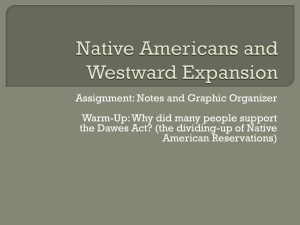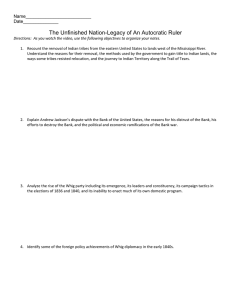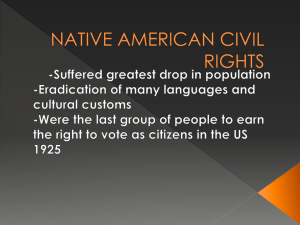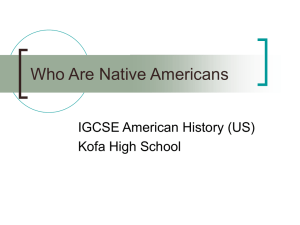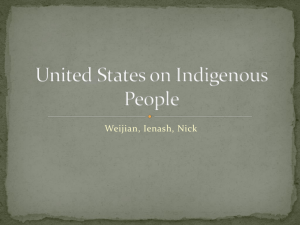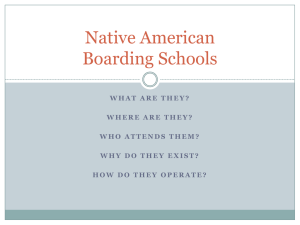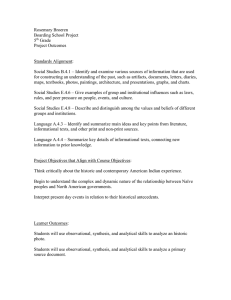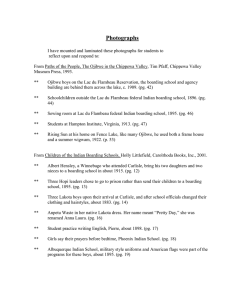Native Americans in the US: The effects of *manifest destiny*
advertisement
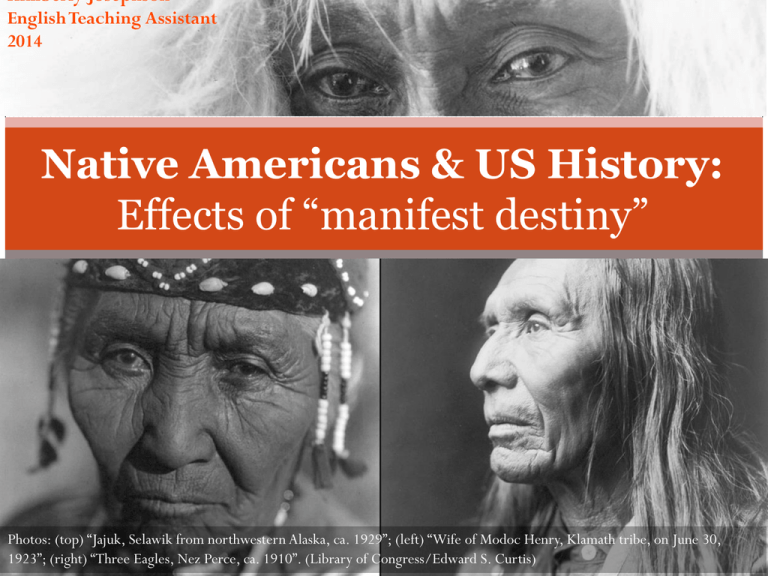
Kimberly Josephson English Teaching Assistant 2014 Native Americans & US History: Effects of “manifest destiny” Photos: (top) “Jajuk, Selawik from northwestern Alaska, ca. 1929”; (left) “Wife of Modoc Henry, Klamath tribe, on June 30, 1923”; (right) “Three Eagles, Nez Perce, ca. 1910”. (Library of Congress/Edward S. Curtis) Policies Removal Act 1830 Trail of Tears “Peace” Policy 1868/9 Assimilation Dawes Act 1887 Indian Reorganization Act 1934 Policy reversal Termination Policy 1940s – 1960s Reversal… again “Self-Determination” & Education Assistance Act 1975 “Fractionation” 138 million acres 48 million Resources, law enforcement, education, etc. Assimilation Era (1880s – 1920s) Photo: “Chiricahua Apaches as they arrived at Carlisle from Fort Marion, Florida” by John N. Choate, November 4, 1886 Assimilation Era (1880s – 1920s) Photo: “Chiricahua Apaches four months after arriving at Carlisle” by John N. Choate Native American Boarding Schools http://www.mtholyoke.edu/~sprag20h/carlisleindianschool.html “…kill the Indian and save the man” (Capt. Richard H Pratt) Carlisle Indian Industrial School (1879 – 1918) Means of assimilation Appearance: Victorian era-style clothing, shaved heads Language: English only (“those caught ‘speaking Indian’ were severely punished.”) Religion: Forced Christian prayer Schedule: Military-like daily regimen Curriculum: Academic, vocational, & farming techniques Argentina? “Soul Wound.” Some schools remained open until the 1980s Forced enrollment ended in the 1930s “Our Spirits Don't Speak English: Indian Boarding School” Similar system adopted by Canada Investigations (US & Canada) into emotional, sexual, and physical abuse: reports of poisoning, starving, electric shock, beating, sterilization, rape https://www.youtube.com/watch?v=G1TCQf2NTFc “ ‘Native America knows all too well the reality of the boarding schools,’ writes Native American Bar Association President Richard Monette, who attended a North Dakota boarding school, ‘where recent generations learned the fine art of standing in line single-file for hours without moving a hair, as a lesson in discipline … where the sharp rules of immaculate living were instilled through blistered hands and knees on the floor with scouring toothbrushes; where mouths were scrubbed with lye and chlorine solutions for uttering Native words.” Excerpt: “Soul Wound: The Legacy of Native American Schools” (Andrea Smith, Amnesty, March 2007) “Richard Stone, left, and Tyler Owens stand near the tree where a Native American girl and her father both committed suicide in Sacaton, Ariz. Owens, who lives across the street from this tree, said: “In Indian Country, youths need to have somebody there for them. I wish I had been that somebody for the girl in the tamarisk tree.” Linda Davidson/TheWashington Post Self-Determination Era (1970s – ) Washington Post article “The hard lives – and high suicide rate – of Native American children on reservations” by Sari Horwitz(March 9, 2014) Populations & reservations today 2.9 – 5.2 million people (0.9 – 1.7%) Most (78%) of the population lives off reservations Largest tribes: Cherokee and Navajo California, Arizona, Oklahoma Local sovereignty for 562 tribes Government contracts with tribes, like other states “domestic dependent nations” Critiques? Historical trauma & other issues Disproportionate [documented] rates of: Poverty Diabetes Depression Crime Tuberculosis Sports mascots Washington Redskins (NFL) Cleveland Indians (MLB) “Native American” vs. “American Indian” Native American Gambling Industry Alcoholism Suicide Native Languages Near extinction in most tribes Attempts at rebirth: Wampanoag communities of Massachusetts “There is nothing I know of that's anything like the Wampanoag case.” Noam Chomsky Sources Pictures: http://www.theatlantic.com/infocus/2013/04/native- americans-portraits-from-a-century-ago/100489/; http://www.loc.gov/teachers/classroommaterials/primarysourcesets/ assimilation/ Policies: http://lawlib.lclark.edu/blog/native_america/wpcontent/uploads/2010/03/Indian-Policies.pdf Boarding schools: https://content.lib.washington.edu/aipnw/marr.html Washington Post article: http://www.washingtonpost.com/world/national-security/the-hardlives--and-high-suicide-rate--of-native-americanchildren/2014/03/09/6e0ad9b2-9f03-11e3-b8d894577ff66b28_story.html
